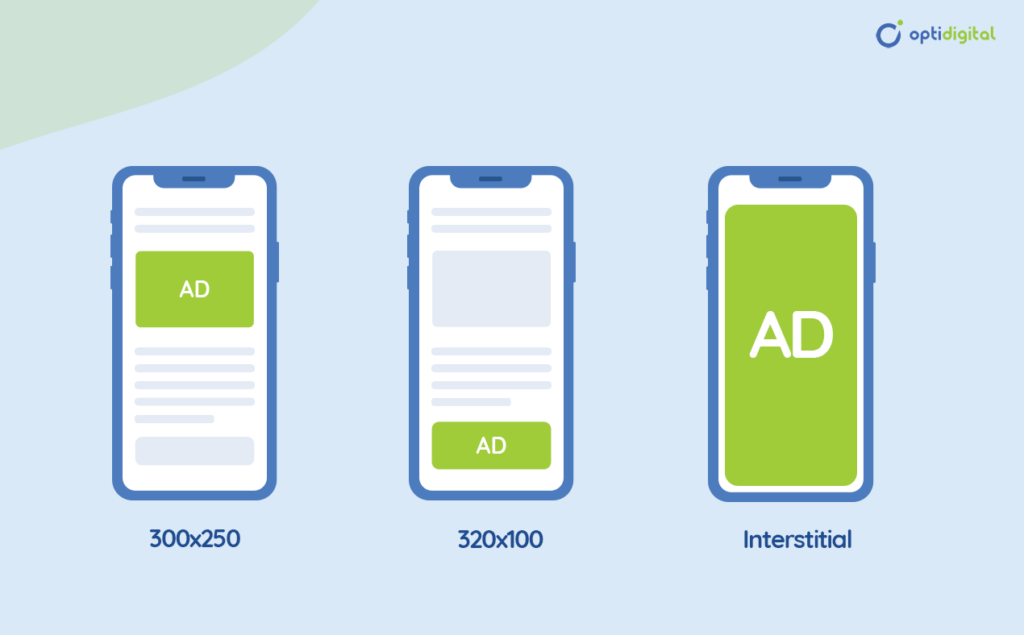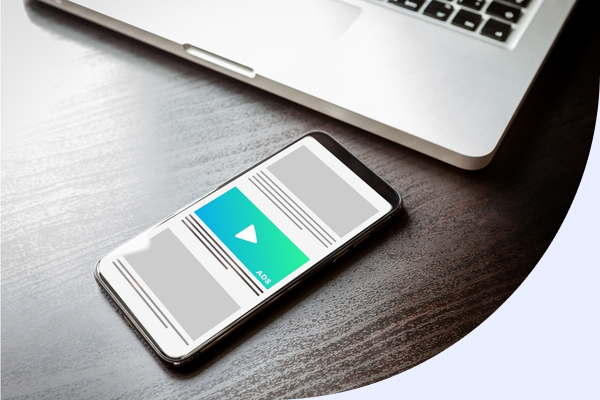After a couple years dominated by stable or negative variations in programmatic ad revenue for content and news media publishers, 2024 marks a turning point in the ad tech world, switching from a third-party cookie-based ecosystem to a new era more respectful of user privacy.
While our technologies are fully cookieless-ready at Opti Digital, we keep on the lookout for the most recent trends and the best performing website layout too in order to maximize publishers income. Let’s analyze advertising placements based on current trends and technological advances. Which Ad Formats give the best results to publishers, maximizing monetization opportunities in 2024?
Most popular Ad Sizes
Mobile
Mobile advertising already accounts for more than 60% of total digital advertising revenue (in US dollars) and this figure is expected to continue to rise. According to Statista, spending will reach $400 billion by 2024.
Banner sizes such as MPU in 300×250 px, Mobile Leaderboards in 320×50 px and 320×100 px record some of the highest eCPMs, as they can display messages prominently and without interruption, if distributed harmoniously in the content or if placed at the top or bottom of a mobile screen and offering high viewability to advertisers thanks to a sticky or anchored behavior.
Also, in 2024 tactile interstitial ad formats are performing especially well, with common dimensions of 320×480 on mobile web pages and offering a high eCPM. It is a full-screen format displayed in overlay on the website. It is usually displayed on click when users transition from one page to another in the same media. In late 2023, Google started offering new triggers to pop the ad up. Interstitials are worth testing as they could bring significant revenue. Supporting different media types (video, img and txt), they will continue to assert themselves as one of the most cost-effective formats.
Beyond classic formats, other formats can be used such as native ads, for a better user experience, or video format, to capture the user’s attention. For example, from Opti Digital we analyze that the preroll format for mobile offers excellent eCPM.
Read more: The Most Profitable Ad Formats in 2023

Display
And we had noted in our previous article how display advertising formats continue to attract a high amount of advertising investment.
For example, the most profitable and best performing ad formats are still some banner ads such as billboard, anchored billboard and leaderboard. Formats such as MPU (Mid-page Unit), also sometimes called a medium rectangle in 300×250 keep on attracting investments when viewability is high, especially when placed in-read, in between the content 728×90 and 970×250 represent banner ads that are easy to implement in full-width to attract the user’s attention.
To make ads as profitable as possible for publishers, format is not the only thing to consider. Ad placement and behavior are key too. For example, from Opti Digital we can say that banner ads placed in the sidebar, with the typical half page Ad size in 300×600, perform better when they slide along the content. This stickiness improves viewability and click-through rates and enables users to refresh the ad after a delay to grow the volume of ads displayed while remaining in the same ad unit. So the best website ad layout takes into consideration placement, ad format and ad behavior and is one of the highest impact levers for the monetization strategy.
Video
Video continues to gain importance in the ad landscape, and its formats can be summarized in two main categories: in-stream and out-stream. To make the right choice, publishers have to keep several factors in mind.
Out-stream formats, such as those offered by Opti Digital, integrate easily in the content and can be combined with other media types in different ad placements of the web. They may appear in non-video environments, such as text-based content, considered less intrusive and are more suitable for mobile inventories, as suggested by 60% of brand professionals.
On the other hand, in-stream ads, such as preroll or midroll, need a video environment to be viewed. Brands pay high CPMs to get the high level of user attention on the following video content. .
With the aim of retaining the attention of the user without invading their browsing experience, innovative formats such as “bumpers” continue to gain success. These short formats, of maximum 6 seconds, are designed to send a message directly and concisely, capturing the attention of the user in the shortest possible time.
Native Advertising Remains a Bright Spot
With the move away from third-party cookie-based targeting, native ads that rely on publishers’ first-party data and contextual targeting are becoming the new hype. With an estimated 45% year-over-year global growth, data indicates that by 2025, native advertising will reach a spend of $402.33 billion.
At Opti Digital, our in-ad format uses IAB standard containers, promoting relevant content to the user, and its effectiveness is measured based on brand parameters such as interaction and brand lift.
In 2023 we also launched an innovative format, Opti Engage, which is able to deliver native ads respecting IAB standard dimensions. It fully respects the website layout and UX and does not cause any content shift protecting the media core web vital scores. In addition, Opti Digital takes care of the rendering of the native ad feeds on behalf of the publishers. Thanks to its technology and engaging display, it achieves a significant increase in monetization in more than 1700 media, anecdotally ranking in the Top 3 SSPs and with a proven average revenue lift of 7%.
A new paradigm for the future
Contextual Advertising: The New Era of Targeted Ads
With the removal of third-party cookies by Google in 2024, contextual targeting is strongly coming back and hype again and has become a fundamental strategy to reach the audience target. “Contextual targeting”allows the ad to be positioned in the right context so that it matches user interest: For example, a campaign promoting a new car targets media in the automotive category.is A study shows that almost 80% of users favorably accept advertising that relates to their interests or previous searches.
Looking ahead to 2024, the development of artificial intelligence and machine learning capabilities enables the analysis of large amounts of data, offering the opportunity to show ads in the most functional form. In addition, the incorporation of multi-sensor AR capabilities for real-life object recognition will take contextual advertising to a new level of personalized immersion.
As a publisher, you may provide your contextual data to boost your revenue. You must send the IAB category of the website and page in the bid request to your demand partners in order to enable advertisers to target your inventory with tailored ads. Bid decoration plays a key role. The IAB Tech Lab offers specifications on how to enrich bid requests with additional information in the Sellers Defined Audience (SDA) project. In an era marked by the decline of third-party cookies, these types of signals provide valuable information, fostering a more informed and targeted advertising experience. You should also pick your demand partners according to their capacity to deliver contextual advertising.
Attention-Based Advertising
Anyway, as user attention spans decrease each year, new attention metrics now complement traditional metrics. Attention-based services reward publishers based on actual viewer engagement rather than mere impressions. To be successful, ads must be optimized, not distracting and offer genuine value, because of all the offerings on the market, almost only 20% of ads are viewed by users. For the publishers, tracking attention scores provides full transparency into the effectiveness of the inventory and enables them to select and sell ad placements based on attention. While these same attention metrics are still nascent, they may increasingly influence the future of authentic, non-intrusive monetization.
Since last year, Opti Digital has focused on predicting attention-levels in order to bid accordingly on publishers’ inventory. We have also released an ad format that uses the same codes as social media in order to capture the reader’s attention. The ad formats made available though the Opti Engage bid adapter have a user-centric design and deliver a message that truy resonates improving the CTR, the user experience and increasing eCPM.
Conclusions
Privacy issues, user behaviors, and technological changes continue to shape the advertising landscape, and it is critical for publishers to implement the right strategies to reach their audiences during 2024.
From Opti Digital, we want to be always ahead and interpret the times, to offer the solutions that best suit the needs of each publisher. As we know that keeping the attention of the users is increasingly difficult, we released Opti Engage, a unique ad format respecting IAB standards, attractive and improving attention metrics to increase ad monetization.
And in 2024 we wanted to go further. We have re-engineered the Opti All-in-One ad solution with a new extremely light monetization tag. It guarantees both the best web performance and an immediate ad load. Both a great volume and a great quality of ads displayed to maximize publishers ad revenues.. If you are interested, discover our new advertising solution here.



